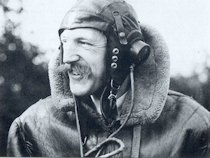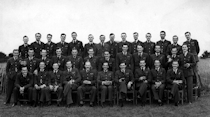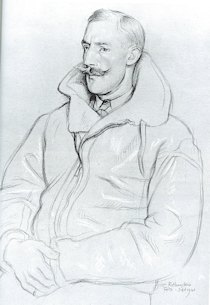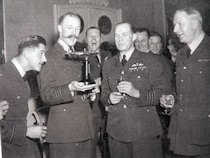W/Cdr. Bertie Rex O'Bryen Hoare
Bertie Rex O'Bryen Hoare was born on 6 June 1912. He was the son of Cyril Bertie Edward O'Bryen Hoare and Isabel Mary Fielder.
Bertie Rex O'Brien 'Sammy' Hoare was one of the truly great RAF 'characters' of WWII complete with glass eye and six inch handlebar moustache, and is acknowledged as one of the finest Mosquito Intruder pilots. He died on 26 March 1947 at age 34, following an air accident over the Pacific flying - appropriately - a Mosquito.
He married Lucy Watson, daughter of Richard Nimmo Watson, on 22 December 1945. He was educated at Harrow School, London. He fought in the Second World War, and was mentioned in despatches three times. He was decorated with the award of Distinguished Flying Cross (D.F.C.) (and bar).
He is credited with 9 victories on 23 and 605 Squadrons and was decorated with the award of Companion, Distinguished Service Order D.S.O. (1942) and bar (1944). He gained the rank of Wing Commander in the service of the Royal Air Force.
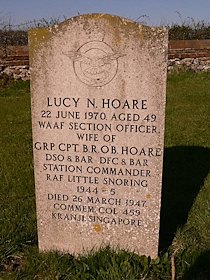 His only child was Rosemary Verity, born after his death on 1 Nov 1947. His wife Lucy Watson was the daughter of Richard Nimmo Watson. She married Bertie Hoare on 22 December 1945. She died on 21 June 1970 and her gravestone exists still in Little Snoring graveyard. Her husband's grave is in Singapore, for which see the link above.
His only child was Rosemary Verity, born after his death on 1 Nov 1947. His wife Lucy Watson was the daughter of Richard Nimmo Watson. She married Bertie Hoare on 22 December 1945. She died on 21 June 1970 and her gravestone exists still in Little Snoring graveyard. Her husband's grave is in Singapore, for which see the link above.
Lucy gained the rank of Senior Officer in the service of the Women's Auxiliary Air Force.
Biography
Bertie Hoare entered the RAF on a short-service commission in 1936, having been educated at Harrow and Wye Agricultural College. The London Gazette for 4th May 1937 confirms him in his appointment as a pilot officer. (Source)
The same paper on 30th May 1941 commends Bertie Hoare (now Squadron 23) for his skillful, effective night missions and his bravery. (Source) and again in October 1942 when he had "completed numerous operational sorties over enemy occupied territory during which he destroyed six enemy aircraft" (Source)
His exploits are mentioned in the book "Mosquito Aces of World War 2" by Andrew Thomas & Chris Davey, and a more detailed account is given in the book "Mosquito Fighter/Fighter-Bomber Units of World War 2" By Martin W. Bowman. (Page One) and (Page Two).
He was red-haired, with the famous handlebar moustache - he reckoned that if both ends couldn't be seen from behind, it wasn't worth the name 'handlebar'.
Lost his eye
Bertie lost an eye early in his flying career, or in other accounts it says he was left with a damaged eye. The facts are now difficult to establish. One account says he was injured in flight when "a duck flew through his windscreen" and that afterwards he had a glass eye, for "he had one brown eye, one blue - no-one seemed to know which was the glass one...."
Another account reads thus: "About the time that the war started in Europe Bertie was piloting a Fairey Battle Mk. I from Cranfield. With him was Doug Wilson an N.C.O. W.A.G. Wilson also went on to become Group Douglas Captain Wilson. Bertie took a hit in the face from a loose engine cowling. The resultant blow popped an eye out of its socket and he landed due to his great skill and a bit of luck. Bertie was hospitalized for a six month period. A very strange thing happened as a result of the accident. The injured eye now had amazing night vision capabilities. [thus he ended up as a night fighter.].
It does seem to me more likely that he lost the eye entirely, but the story of amazing night vision helped him retain his position as a pilot, indeed enhanced it!
Forum Thread on 12 o'clock High
Some have tried (without any success) to discover the date and exact circumstances of this incident which supposedly occurred in either late September or early October 1939 while serving with 207 Squadron. It seems unlikely to have been 23/03/1939 as stated, as there is a picture of Hoare taken in July 1938 with 207 Sqd. As it has been said that he was off for 6 months, it looks to be an incident after then.
Quote: I was aware of the site of 207 Squadron´s Association, where I researched. But there is NO positive identification of the serial number neither the codes of the aircraft involved.
There was another member (Wilson) of the Squadron with him. He landed all right, although severly injured.
I could not confirm the serial number as being L4967 or the date of the incident as 23/03/1939, (WW2 website, post now deleted.)
Another website claims that "Fellow crew member was Douglas Wilson and it happened at RAF Cranfield.
There was a change in command in October 1939 after Hoare's accident.
No use in looking for a Fairey Battle crash, for there was none."
Career in the RAF
Bertie Hoare flew Intruder Operations in Bostons and then Mosquitos. His daring exploits earned him numerous medals including D.S.O.'s and D.F.C.'s. He finished the last part of the Second World War as Station Commander of R.A.F. Station Little Snoring Norfolk. .
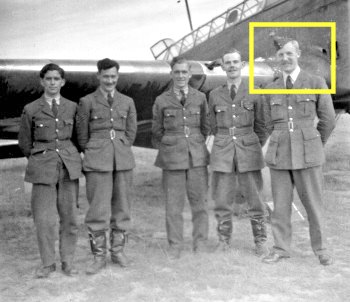
He was an early exponent of intruding, flying Blenheims and then Havocs over the Low Countries. In July 1942, 23 Squadron converted to Mosquito NFIIs with increasing success. When 23 Sqd went to Malta in early 1943, 'Sammy' set up a specialized Intruder training school at Cranfield before posting to 605 Squadron as CO, again on Mosquitos.
Then came his period as Station CO at Little Snoring, continuing to fly and score victories which are recorded on the scoreboards preserved in St Andrews Church. His briefings to crews are fondly remembered ; one well-known and typical example finished :
'Gentlemen, there will be flak; almost certainly quite heavy flak. If you cannot go over, you will go under. If you cannot go under - you will go through!"
Award and Presentation
In the photograph to the right (in sidebar) we see 'Sammy' as perhaps he might like to be remembered - the centre of attention - holding the silver model of a Mosquito which had just been presented to celebrate 605 Squadron's '100th Hun' at a party at the Dorchester Hotel, London in April 1944.
The ages of the men in the photo has caused comment. It turns out that, for this special occasion, many pre-war officers of 605 Squadron were invited. The four main people in the photo are (L-R) F/O Leo Williams DFC, W/Cdr Sammy Hoare DSO DFC, Group Captain J A C Wright (who was the first-ever CO of 605 Sqn) and lastly Air Commodore Sir Lindsay Everard MP.
And the model Mosquito? Apparently it is held in safe-keeping among the collection of RAF silverware at Stratford-on-Avon Town Hall.
There are various conflicting accounts of the death of Commander Hoare:
Hoare remained in the RAF post-war, joining 84 Squadron. On 26th March 1947 he was reported missing whilst ferrying a Mosquito to Australia. Mystery surrounds this incident ; Christopher Shores in 'Aces High' states that the Mosquito crash-landed on a remote island, the crew perishing of thirst before they could be found - whereas other sources state that the aircraft crashed into the sea. [It is thought that a relative of his was born in Christchurch which may have attracted him to make the flight to New Zealand.]
One forum post says "There is another story about Hoare's demise which is rather more distressing. It turned up in a book by another Mosquito pilot who does not mention Hoare's name, but the way the story is told it can only be him." but the post was never followed up. We can only speculate.
Did the plane crash into the sea, or did it make a successful landing on an isolated island? Were the bodies missing, or found "lying under the wing of the aircraft"? Did they die of injuries, thirst and hunger, or even at the hand of natives who found them there? Was the wreckage discovered earlier than 3rd April but only reported at that time when both men were dead? We will never really know.
However, it is established that Bertie Hoare was killed with his navigator when the Mosquito which they were delivering to New Zealand crashed in the Gulf of Carpentaria in N.Australia. "Mosquito FB.VI TE746 crashed into the Gulf of Carpentaria on March 26 1947 with the loss of both crew (W/C B.R. Hoare and F/O W. Colvin RAF)."
The delivery
The ex-RAF Mosquito had been purchased by the RNZAF and was on its delivery flight to New Zealand. The aircraft left Darwin in company with TE927 at 09:08 hours on 26 March 1947. Both aircraft were reported overdue in bad weather at 12:35 but TE927 landed at Macrossan shortly after 13:00. Flying through a tropical storm over the Gulf of Carpentaria the Mosquito crashed in shallow water just off the northern tip of Sydney Island. It is believed that they flew the aircraft into the water as they were trying to get a visual reference to determine their approximate location after losing their radio. The wreckage of the aircraft was found on the 3rd of April. (source)
- W/Cdr (37853) Bertie Rex O'Bryan HOARE (pilot) RAF - killed
- P/O (194.363) Walter COLVIN (nav.) RAFVR - killed
Colvin was not a New Zealander but is listed as a New Zealand casualty because he was lost in an RNZAF aircraft. He had been attached from 84 Sqn RAF to the RNZAF Ferry Flight to undertake the delivery. He is mentioned in Don Neate's 84 Sqn history - The Scorpion's Sting - as being 'an extremely popular officer'
At 1300 TE927 touched down at an emergency landing ground at Macrossan some 60 miles south of Townsville but there was no sign of its companion. An aerial search over the next week failed to find the missing TE746 but on 3 April a message from the mission station on Mornington Island in the Gulf of Carpentaria stated that a native two days earlier had found aircraft wreckage washed up some 20 miles away on the beach at Sydney Island.
A launch sent from Mornington discovered the wrecked Mosquito lying in the shallows at the island. The two crew are commemorated on the Singapore Memorial. Hampered by an unserviceable radio and flying in very turbulent weather and poor visibility it was thought that they had flown into the water while trying to establish their position.
Having survived several near misses pre war, and the subsequent years engaged in aerial combat, it seems unjust that Bertie lost his life post war.
Bertie was aged only 35 when he died. He left a young wife, and an unborn baby - a real tragedy for all concerned. His daughter Rosemary was born seven months after his death.
HOARE, BERTIE REX O’BRYEN. D.S.O. & Bar, D.F.C. & Bar.
Wing Commander, 37853.
84 Squadron, Royal Air Force.
Died 26 March 1947. Aged 35.
Son of Bertie and Mary Hoare.
Husband of Lucy N. Hoare of Nairobi, Kenya.
Commemorated on the Singapore Memorial. Column 459.

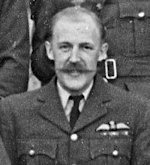
 His only child was Rosemary Verity, born after his death on 1 Nov 1947. His wife Lucy Watson was the daughter of Richard Nimmo Watson. She married Bertie Hoare on 22 December 1945. She died on 21 June 1970 and her gravestone exists still in Little Snoring graveyard. Her husband's grave is in Singapore, for which see the link above.
His only child was Rosemary Verity, born after his death on 1 Nov 1947. His wife Lucy Watson was the daughter of Richard Nimmo Watson. She married Bertie Hoare on 22 December 1945. She died on 21 June 1970 and her gravestone exists still in Little Snoring graveyard. Her husband's grave is in Singapore, for which see the link above.
